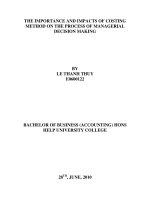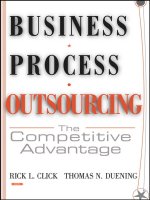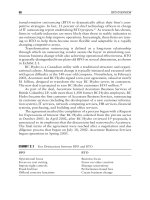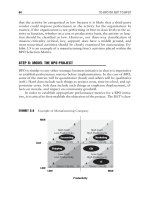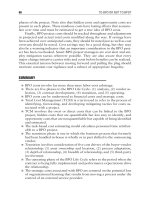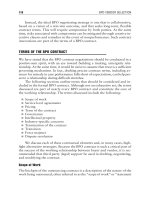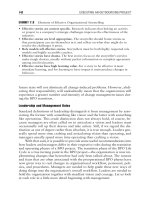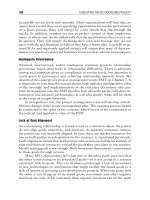Management ch 09 managerial decsion making
Bạn đang xem bản rút gọn của tài liệu. Xem và tải ngay bản đầy đủ của tài liệu tại đây (1000.38 KB, 29 trang )
Chapter 9
Managerial Decision Making
Managerial Decision Making
Decision
It
–
–
–
making is not easy
must be done amid
ever-changing factors
unclear information
conflicting points of view
Manager’s Challenge: Tupperware
2
Copyright © 2005 by South-Western, a division of Thomson Learning. All rights reserved.
Managerial
Decision Making
Decision
Topics
Chapter 9
Characteristics
Decision-making
Models
Steps
Executives Take Making Important
Decisions
Participative
Decision Making
Techniques
for Improving Decision Making in
Today’s Organizations
3
Copyright © 2005 by South-Western, a division of Thomson Learning. All rights reserved.
Decisions and Decision Making
Decision = choice made from available
alternatives
Decision
Making = process of identifying
problems and opportunities and resolving
them
4
Copyright © 2005 by South-Western, a division of Thomson Learning. All rights reserved.
Categories of Decisions
Programmed
Decisions
Situations occurred often enough to enable
decision rules to be developed and applied in
the future
– Made in response to recurring organizational
problems
Nonprogrammed Decisions – in response to
unique, poorly defined and largely unstructured,
and have important consequences to the
organization
–
Ethical Dilemma: The No-Show Consultant
5
Copyright © 2005 by South-Western, a division of Thomson Learning. All rights reserved.
Decisions and Decision Making
Many
decisions that managers deal with
every day involve at least some degree of
uncertainty and require nonprogrammed
decision making
6
May be difficult to make
Made amid changing factors
Information may be unclear
May have to deal with conflicting points of view
Copyright © 2005 by South-Western, a division of Thomson Learning. All rights reserved.
Certainty, Risk, Uncertainty, Ambiguity
●
Certainty
●
●
Risk
●
●
●
●
managers know which goals they wish to achieve
information about alternatives and future events is incomplete
managers may have to come up with creative approaches to
alternatives
Ambiguity
●
●
●
●
7
decision has clear-cut goals
good information is available
future outcomes associated with each alternative are subject to
chance
Uncertainty
●
●
●
●
all the information the decision maker needs is fully available
by far the most difficult decision situation
goals to be achieved or the problem to be solved is unclear
alternatives are difficult to define
information about outcomes is unavailable
Copyright © 2005 by South-Western, a division of Thomson Learning. All rights reserved.
Conditions that Affect the Possibility of
Decision Failure
Organizational
Problem
Low
Possibility of Failure
Certainty
Risk
Uncertainty
Programmed
Decisions
Ambiguity
Nonprogrammed
Decisions
Problem
Solution
8
High
Copyright © 2005 by South-Western, a division of Thomson Learning. All rights reserved.
Selecting a Decision Making Model
Depends
on the manager’s personal preference
Whether the decision is programmed or nonprogrammed
Extent to which the decision is characterized by
risk, uncertainty, or ambiguity
9
Copyright © 2005 by South-Western, a division of Thomson Learning. All rights reserved.
Three Decision-Making Models
Classical Model
Administrative Model
Political Model
10
Copyright © 2005 by South-Western, a division of Thomson Learning. All rights reserved.
Classical Model
Logical decision in the organization’s best economic interests
Assumptions
Decision maker operates to accomplish goals that
are known and agreed upon
Decision maker strives for condition of certainty –
gathers complete information
Criteria for evaluating alternatives are known
Decision maker is rational and uses logic
Normative = describes how a manager should and
provides guidelines for reaching an ideal decision
11
Copyright © 2005 by South-Western, a division of Thomson Learning. All rights reserved.
Administrative
Model
Herbert A. Simon
How nonprogrammed decisions are made--uncertainty/ambiguity
12
Two concepts are instrumental in shaping the
administrative model
●
Bounded rationality: people have limits or
boundaries on how rational they can be
●
Satisficing: means that decision makers choose
the first solution alternative that satisfies minimal
decision criteria
Copyright © 2005 by South-Western, a division of Thomson Learning. All rights reserved.
Administrative Model
How nonprogrammed decisions are made--uncertainty/ambiguity
●
Managers actually make decisions in difficult situations
characterized by non-programmed decisions, uncertainty,
and ambiguity
●
●
Decision goals often are vague, conflicting and lack consensus
among managers;
Rational procedures are not always used
Managers’ searches for alternatives are limited
Managers settle for a satisficing rather than a maximizing solution
intuition, looks to past experience
●
Descriptive = how managers actually make decisions--not how
●
●
●
they should
13
Copyright © 2005 by South-Western, a division of Thomson Learning. All rights reserved.
Political Model
Closely resembles the real environment
14
●
Closely resembles the real environment in which most
managers and decision makers operate
●
Useful in making non-programmed decisions
●
Decisions are complex
●
Disagreement and conflict over problems and solutions
are normal
●
Coalition = informal alliance among manages
who support a specific goal
Copyright © 2005 by South-Western, a division of Thomson Learning. All rights reserved.
Characteristics of Classical, Political, and
Administrative Decision Making Models
Classical Model
Administrative Model
Clear-cut problem and goals
Vague problem and goals
Pluralistic; conflicting goals
Condition of certainty
Condition of uncertainty
Condition of uncertainty/ambiguity
Full information about
Limited information about
Inconsistent viewpoints; ambiguous
alternatives and their outcomes
Alternatives and their outcomes
information
Rational choice by individual
Satisficing choice for resolving
Bargaining and discussion among
for maximizing outcomes
problem using intuition
coalition members
15
Copyright © 2005 by South-Western, a division of Thomson Learning. All rights reserved.
Political Model
Six Steps in the Managerial
Decision-Making Process
Evaluation Recognition of
and
Decision
Feedback
Requirement
Implementation
of Chosen
Alternative
DecisionMaking
Process
Selection of
Desired
Alternative
16
Diagnosis
and Analysis
of Causes
Development of
Alternatives
Copyright © 2005 by South-Western, a division of Thomson Learning. All rights reserved.
Diagnosis and Analysis of Causes
Diagnosis = analyze underlying causal
factors associated with the decision situation
Managers
make a mistake if they jump into
generating alternatives without first exploring
the cause of the problem more deeply
17
Copyright © 2005 by South-Western, a division of Thomson Learning. All rights reserved.
Underlying Causes - Kepner /Tregoe
18
What is the state of disequilibrium affecting us?
When did it occur?
Where did it occur?
How did it occur?
To whom did it occur?
What is the urgency of the problem?
What is the interconnectedness of events?
What result came from which activity?
Copyright © 2005 by South-Western, a division of Thomson Learning. All rights reserved.
Selection of Desired Alternatives
Risk
Propensity = willingness to undertake
risk with the opportunity of gaining an
increased payoff
Implementation
= using managerial,
administrative, and persuasive abilities to
translate the chosen alternative into action
19
Copyright © 2005 by South-Western, a division of Thomson Learning. All rights reserved.
Decision Styles
Differences
among people with respect to how
they perceive problems and make decisions
Not
–
–
–
–
20
all managers make decisions the same
Directive style
Analytical style
Conceptual style
Behavioral style
Copyright © 2005 by South-Western, a division of Thomson Learning. All rights reserved.
Personal Decision Framework
Situation:
· Programmed/nonprogrammed
· Classical, administrative,
political
· Decision steps
21
Personal Decision
Style:
·Directive
·Analytical
·Conceptual
·Behavioral
Copyright © 2005 by South-Western, a division of Thomson Learning. All rights reserved.
Decision Choice:
·Best Solution to
Problem
Directive Style
People
who prefer simple, clear-cut solutions
to problems
Make decisions quickly
May consider only one or two alternatives
Efficient and rational
Prefer rules or procedures
22
Copyright © 2005 by South-Western, a division of Thomson Learning. All rights reserved.
Analytical Style
Complex
solutions based on as much data as
they can gather
Carefully consider alternatives
Base decision on objective, rational data
from management control systems and other
sources
Search for best possible decision based on
information available
23
Copyright © 2005 by South-Western, a division of Thomson Learning. All rights reserved.
Conceptual Style
24
Consider a broad amount of information
More socially oriented than analytical style
Like to talk to others about the problem and possible
solutions
Consider many broad alternatives
Relay on information from people and systems
Solve problems creatively
Copyright © 2005 by South-Western, a division of Thomson Learning. All rights reserved.
Behavioral Style
Have a deep concern for others as individuals
Like to talk to people one-on-one
Understand their feelings about the problem and the
effect of a given decision upon them
Concerned with the personal development of others
May make decisions to help others achieve their
goals
Experiential Exercise: What’s Your Personal Decision Style?
25
Copyright © 2005 by South-Western, a division of Thomson Learning. All rights reserved.

